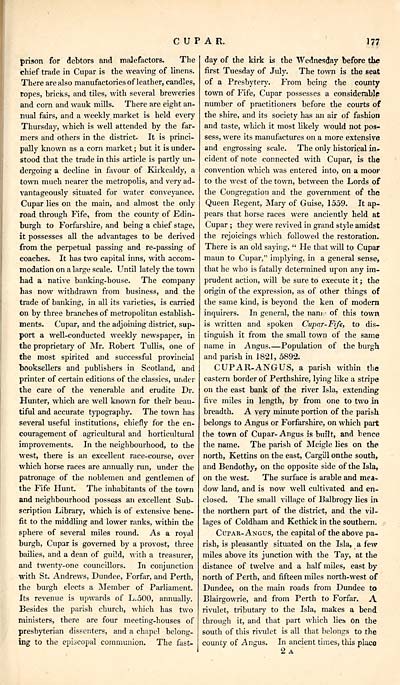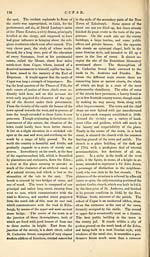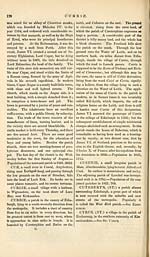Gazetteer of Scotland > Volume 1
(205) Page 177
Download files
Complete book:
Individual page:
Thumbnail gallery: Grid view | List view

CUPAR.
177
prison for debtors and malefactors. The
chief trade in Cupar is the weaving of linens.
There are also manufactories of leather, candles,
ropes, bricks, and tiles, with several breweries
and corn and wauk mills. There are eight an-
nual fairs, and a weekly market is held every
Thursday, which is well attended by the far-
mers and others in the district. It is princi-
pally known as a corn market ; but it is under-
stood that the trade in this article is partly un-
dergoing a decline in favour of Kirkcaldy, a
town much nearer the metropolis, and very ad-
vantageously situated for water conveyance.
Cupar lies on the main, and almost the only
road through Fife, from the county of Edin-
burgh to Forfarshire, and being a chief stage,
it possesses all the advantages to be derived
from the perpetual passing and re-passing of
coaches. It has two capital inns, with accom-
modation on a large scale. Until lately the town
had a native banking-house. The company
has now withdrawn from business, and the
trade of banking, in all its varieties, is carried
on by three branches of metropolitan establish-
ments. Cupar, and the adjoining district, sup-
port a well-conducted weekly newspaper, in
the proprietary of Mr. Robert Tullis, one of
the most spirited and successful provincial
booksellers and publishers in Scotland, and
printer of certain editions of the classics, under
the care of the venerable and erudite Dr.
Hunter, which are well known for their beau-
tiful and accurate typography. The town has
several useful institutions, chiefly for the en-
couragement of agricultural and horticultural
improvements. In the neighbourhood, to the
west, there is an excellent race-course, over
which horse races are annually run, under the
patronage of the noblemen and gentlemen of
the Fife Hunt. The inhabitants of the town
and neighbourhood possess an excellent Sub-
scription Library, which is of extensive bene-
fit to the middling and lower ranks, within the
sphere of several miles round. As a royal
burgh, Cupar is governed by a provost, three
bailies, and a dean of guild, with a treasurer,
and twenty-one councillors. In conjunction
with St. Andrews, Dundee, Forfar, and Perth,
the burgh elects a Member of Parliament.
Its revenue is upwards of L.500, annually.
Besides the parish church, which has two
ministers, there are four meeting-houses of
presbyterian dissenters, and a chapel belong-
ing to the episcopal communion. The fast-
day of the kirk is the Wednesday before the
first Tuesday of July. The town is the seat
of a Presbytery. From being the county
town of Fife, Cupar possesses a considerable
number of practitioners before the courts of
the shire, and its society has an air of fashion
and taste, which it most likely would not pos-
sess, were its manufactures on a more extensive
and engrossing scale. The only historical in-
cident of note connected with Cupar, is the
convention which was entered into, on a moor
to the west of the town, between the Lords of
the Congregation and the government of the
Queen Regent, Mary of Guise, 1559. It ap-
pears that horse races were anciently held at
Cupar ; they were revived in grand style amidst
the rejoicings which followed the restoration.
There is an old saying, " He that will to Cupar
maun to Cupar," implying, in a general sense,
that he who is fatally determined upon any im-
prudent action, will be sure to execute it ; the
origin of the expression, as of other things of
the same kind, is beyond the ken of modern
inquirers. In general, the nam:' of this town
is written and spoken Cupar-Fife, to dis-
tinguish it from the small town of the same
name in Angus Population of the burgh
and parish in 1821, 5892.
CUPAR- ANGUS, a parish within the
eastern border of Perthshire, lying like a stripe
on the east bank of the river Isla, extending
five miles in length, by from one to two in
breadth. A very minute portion of the parish
belongs to Angus or Forfarshire, on which part
the town of Cupar- Angus is built, and hence
the name. The parish of Meigle lies on the
north, Kettins on the east, Cargill onthe south,
and Bendothy, on the opposite side of the Isla,
on the west. The surface is arable and mea-
dow land, and is now well cultivated and en-
closed. The small village of Balbrogy lies in
the northern part of the district, and the vil-
lages of Coldham and Kethick in the southern.
Cupar- Angus, the capital of the above pa-
rish, is pleasantly situated on the Isla, a few
miles above its junction with the Tay, at the
distance of twelve and a half miles, east by
north of Perth, and fifteen miles north-west of
Dundee, on the main roads from Dundee to
Blairgowrie, and from Perth to Forfar. A
rivulet, tributary to the Isla, makes a bend
through it, and that part which lies on the
south of this rivulet is all that belongs to the
county of Angus. In ancient times, this place
2 a
177
prison for debtors and malefactors. The
chief trade in Cupar is the weaving of linens.
There are also manufactories of leather, candles,
ropes, bricks, and tiles, with several breweries
and corn and wauk mills. There are eight an-
nual fairs, and a weekly market is held every
Thursday, which is well attended by the far-
mers and others in the district. It is princi-
pally known as a corn market ; but it is under-
stood that the trade in this article is partly un-
dergoing a decline in favour of Kirkcaldy, a
town much nearer the metropolis, and very ad-
vantageously situated for water conveyance.
Cupar lies on the main, and almost the only
road through Fife, from the county of Edin-
burgh to Forfarshire, and being a chief stage,
it possesses all the advantages to be derived
from the perpetual passing and re-passing of
coaches. It has two capital inns, with accom-
modation on a large scale. Until lately the town
had a native banking-house. The company
has now withdrawn from business, and the
trade of banking, in all its varieties, is carried
on by three branches of metropolitan establish-
ments. Cupar, and the adjoining district, sup-
port a well-conducted weekly newspaper, in
the proprietary of Mr. Robert Tullis, one of
the most spirited and successful provincial
booksellers and publishers in Scotland, and
printer of certain editions of the classics, under
the care of the venerable and erudite Dr.
Hunter, which are well known for their beau-
tiful and accurate typography. The town has
several useful institutions, chiefly for the en-
couragement of agricultural and horticultural
improvements. In the neighbourhood, to the
west, there is an excellent race-course, over
which horse races are annually run, under the
patronage of the noblemen and gentlemen of
the Fife Hunt. The inhabitants of the town
and neighbourhood possess an excellent Sub-
scription Library, which is of extensive bene-
fit to the middling and lower ranks, within the
sphere of several miles round. As a royal
burgh, Cupar is governed by a provost, three
bailies, and a dean of guild, with a treasurer,
and twenty-one councillors. In conjunction
with St. Andrews, Dundee, Forfar, and Perth,
the burgh elects a Member of Parliament.
Its revenue is upwards of L.500, annually.
Besides the parish church, which has two
ministers, there are four meeting-houses of
presbyterian dissenters, and a chapel belong-
ing to the episcopal communion. The fast-
day of the kirk is the Wednesday before the
first Tuesday of July. The town is the seat
of a Presbytery. From being the county
town of Fife, Cupar possesses a considerable
number of practitioners before the courts of
the shire, and its society has an air of fashion
and taste, which it most likely would not pos-
sess, were its manufactures on a more extensive
and engrossing scale. The only historical in-
cident of note connected with Cupar, is the
convention which was entered into, on a moor
to the west of the town, between the Lords of
the Congregation and the government of the
Queen Regent, Mary of Guise, 1559. It ap-
pears that horse races were anciently held at
Cupar ; they were revived in grand style amidst
the rejoicings which followed the restoration.
There is an old saying, " He that will to Cupar
maun to Cupar," implying, in a general sense,
that he who is fatally determined upon any im-
prudent action, will be sure to execute it ; the
origin of the expression, as of other things of
the same kind, is beyond the ken of modern
inquirers. In general, the nam:' of this town
is written and spoken Cupar-Fife, to dis-
tinguish it from the small town of the same
name in Angus Population of the burgh
and parish in 1821, 5892.
CUPAR- ANGUS, a parish within the
eastern border of Perthshire, lying like a stripe
on the east bank of the river Isla, extending
five miles in length, by from one to two in
breadth. A very minute portion of the parish
belongs to Angus or Forfarshire, on which part
the town of Cupar- Angus is built, and hence
the name. The parish of Meigle lies on the
north, Kettins on the east, Cargill onthe south,
and Bendothy, on the opposite side of the Isla,
on the west. The surface is arable and mea-
dow land, and is now well cultivated and en-
closed. The small village of Balbrogy lies in
the northern part of the district, and the vil-
lages of Coldham and Kethick in the southern.
Cupar- Angus, the capital of the above pa-
rish, is pleasantly situated on the Isla, a few
miles above its junction with the Tay, at the
distance of twelve and a half miles, east by
north of Perth, and fifteen miles north-west of
Dundee, on the main roads from Dundee to
Blairgowrie, and from Perth to Forfar. A
rivulet, tributary to the Isla, makes a bend
through it, and that part which lies on the
south of this rivulet is all that belongs to the
county of Angus. In ancient times, this place
2 a
Set display mode to: Large image | Transcription
Images and transcriptions on this page, including medium image downloads, may be used under the Creative Commons Attribution 4.0 International Licence unless otherwise stated. ![]()
| Gazetteers of Scotland, 1803-1901 > Gazetteer of Scotland > Volume 1 > (205) Page 177 |
|---|
| Permanent URL | https://digital.nls.uk/97426822 |
|---|
| Description | Volume I: Abbey to Glenartney. |
|---|---|
| Attribution and copyright: |
|
| Description | By Robert Chambers and William Chambers. Glasgow: Blackie & Son, 1838. 2 volumes. |
|---|---|
| Shelfmark | NF.1461.g.7 |
| Additional NLS resources: | |

